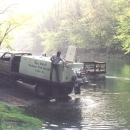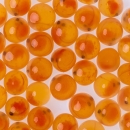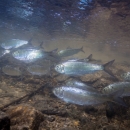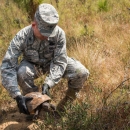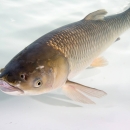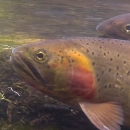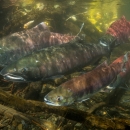What We Do
We Conserve America’s Most Precious Resources
Healthy fisheries and waters are the foundation of America’s outdoor traditions and give us the freedom to fish, boat, and enjoy the benefits of outdoor recreation. America’s freshwater lakes, rivers, and streams are home to some of the most abundant and diverse communities of fish, invertebrates, and plants in the world. Many of these species, such as salmon, trout, Pacific lamprey, river herring, American shad, and striped bass are important cultural, economic, and recreational resources.
Accomplishing Our Mission
The U.S. Fish and Wildlife Service’s mission is “working with others, to conserve, protect, and enhance fish, wildlife, and plants and their habitats for the continuing benefit of the American people.” To accomplish that mission, the Fish and Aquatic Conservation programs work with states, tribes, and communities to provide a comprehensive approach to freshwater conservation: support healthy fish populations, restore their habitat, and protect against invasive species invasive species
An invasive species is any plant or animal that has spread or been introduced into a new area where they are, or could, cause harm to the environment, economy, or human, animal, or plant health. Their unwelcome presence can destroy ecosystems and cost millions of dollars.
Learn more about invasive species . We work with communities to identify problems early, build practical solutions, and measure success.
What We Deliver
- Economic Prosperity: Our programs support $2.1 billion in economic output benefiting families in countless communities across the country. Every $1 million invested through FAC projects generates over $2.5 million in local output and 17+ private‑sector jobs—a proven multiplier that keeps paychecks and spending power in towns across America. (Conserving, Restoring and Enhancing America’s Fisheries and Aquatic Resources)
- Locally Led, Nationally Supported: States, tribes, and partners call us first. We bring national expertise, resources, and scientific tools to address locally identified conservation challenges. Our role is to support community, state and tribal efforts in their own waters.
- Return on Investment: Restoring or updating aquatic infrastructure, releasing healthy fish, and aquatic invasive species management provide significant returns on investment, while maintaining America’s outdoor heritage. From clean water, to safer infrastructure, to healthy fish populations, our programs deliver real outcomes that matter.
Economic Benefits
- Recreational angling from fish stocked by national fish hatcheries supports $1.2 billion in economic output and supports 12,100 jobs nationwide. (FY17)
- Money invested in fish passage fish passage
Fish passage is the ability of fish or other aquatic species to move freely throughout their life to find food, reproduce, and complete their natural migration cycles. Millions of barriers to fish passage across the country are fragmenting habitat and leading to species declines. The U.S. Fish and Wildlife Service's National Fish Passage Program is working to reconnect watersheds to benefit both wildlife and people.
Learn more about fish passage projects supports $520 million in economic value added and represents a 1.5 million return on every million invested. (FY22-FY25) - Invasive species cost the U.S. economy $120 billion annually. FAC-led efforts focus on early detection and coordinated responses to avoid future losses to state and local industry.
Conservation Returns on Investment
National Fish Hatchery System - The National Fish Hatchery System is a global leader in conservation aquaculture. In 2024, the system distributed 223 million fish and aquatic wildlife to enhance state and tribally managed recreational fisheries, boost local economic development, fulfill tribal trust responsibilities, recover threatened and endangered species, and prevent at-risk species from becoming endangered.
2024 By the Numbers
- 73 million fish were stocked to support locally managed recreational fisheries.
- 60 million fish or eggs were transferred to conservation partners like states and tribes.
- 52 million aquatic wildlife were stocked to support restoration and recovery programs.
National Fish Passage Program - For too long, broken dams and outdated culverts have blocked fish, wrecked habitats, and put communities at risk from flooding and infrastructure failure. The National Fish Passage Program is removing barriers, reconnecting rivers, and making America’s waterways work for everyone.
Since 1999, the National Fish Passage Program has worked with more than 2,000 local communities, tribes, and private landowners across the country to remove or bypass more than 3,500 barriers to fish passage and reopened more than 64,000 miles of once inaccessible upstream habitat for fish and wildlife.
2024 By the Numbers
- 97 barriers were removed or upgraded, 2,939 miles of stream habitat were reopened, and 15,026 acres of habitat were reconnected.
- $128 million in total value was added to the economy through investments in fish passage.
Assessment and Monitoring Program – The foundation of data-driven conservation and fisheries management. Fish and Wildlife Conservation Offices operate hundreds of fish and habitat monitoring programs throughout the year in watersheds across the country. The data collected by these programs lets us know what fish are thriving and which need protection. We share this data with states, tribes, and partners to inform decisions about what conservation efforts are working and where more efforts are needed.
2024 By the Numbers
- 1,621 habitat and population assessments were conducted to evaluate the health of our water ways, track fish species, and guide conservation efforts. This data is also used by states and tribes to manage their natural resources.
Aquatic Invasive Species Program - When aquatic invaders threaten our waters, we don’t hesitate, we act. Our programs help states and tribes detect invasive species early and act quickly, reducing the risk of long-term damage to fisheries, infrastructure, and local economies.
2023 – 2024 Investments:
- $4.9 million was invested in state led early detection and rapid response efforts to keep aquatic ecosystems healthy, the economy strong, and the American way of life intact.
- These funds will address species like invasive crayfish, zebra mussels, hydrilla and others
Aquatic Animal Drug Approval Partnership - Since 1999 this specialized research team has contributed to the majority of new fish medications approved in America. This work directly protects and benefits state hatcheries and America’s $4 billion private aquaculture industry.
- Conducted 13,000 studies to ensure medications are safe to aquatic animals.
- Treated 1.5 billion aquatic animals.
- Saved 50 million fish each year for restoration, recovery, recreation, or the dinner table.
Fulfilling Tribal Trust and Subsistence Responsibilities
Natural resource management programs operated by federally recognized tribes protect the traditional, cultural, spiritual, medicinal, subsistence, recreational, and economic needs of their communities within their respective Tribal lands. The collaboration between the Fish and Aquatic Conservation program and tribes plays a crucial role in protecting both natural and cultural resources.
Improving Access - Welcoming the Next Generation
The Fish and Aquatic Conservation program is committed to inspiring future generations to love, understand, and conserve America's natural resources.
2024 By The Numbers
- Visitors to National Fish Hatcheries- 1,338,558
- Fishing Events – 231
- Fish in the Classroom Programs – 366
- Volunteers / Hours - 83,090
We manage a network of cutting-edge conservation offices across the country.

